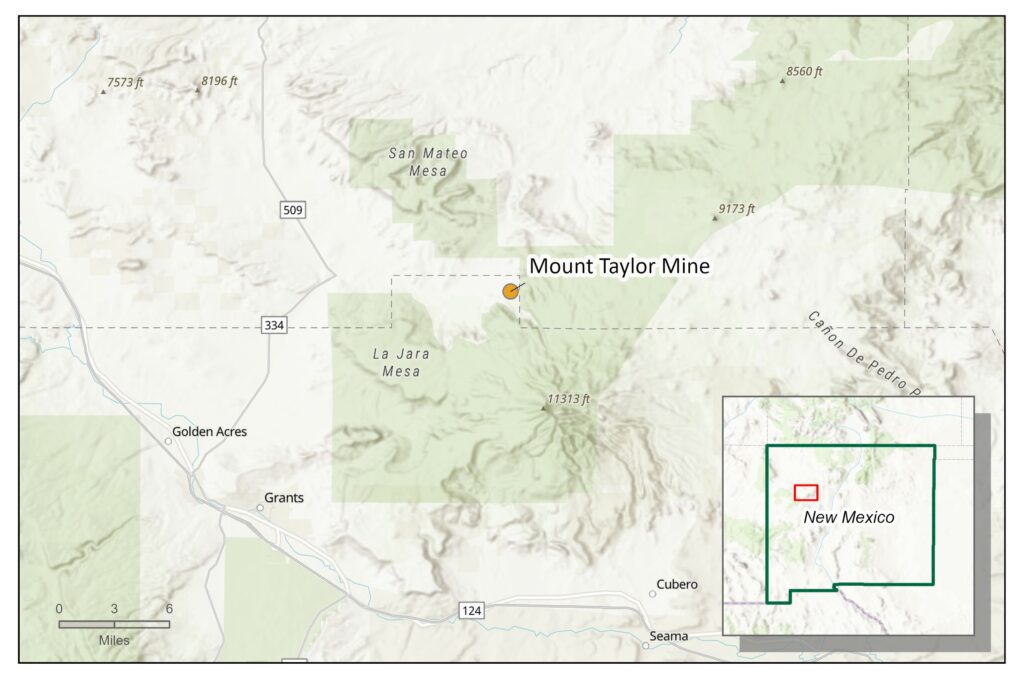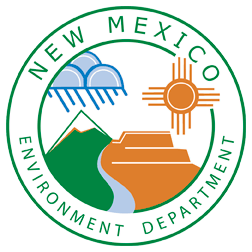Location
The Mt. Taylor Mine is located approximately 18.5 miles northeast of Milan, New Mexico, a half mile northeast of the village of San Mateo in Cibola County, New Mexico, in the eastern half of Section 24, Township 13 North, Range 8 West.

Ownership and History
Gulf Mineral Resources Corporation (Gulf) first purchased the property in 1971. Gulf then began developing the mine workings by constructing two shafts (24- and 14-foot diameter) to access the uranium ore body between 3,100 and 3,200 feet below ground surface within the Westwater Canyon Member of the Morrison Formation. In order to sink the shafts and develop the underground mine, three Gulf dewatered three aquifers through a series of groundwater withdrawal wells installed in the 1970s. The shafts were constructed with traditional drill-and-blast methods with concrete liners. Ore production began in 1980 and continued until September 1982. Gulf merged with Chevron Resources Company (CRC) in 1985, and the property was transferred to CRC. After Gulf merged with CRC, CRC produced ore from 1986 to 1990. CRC used conventional room-and-pillar underground mining methods and extracted approximately 675,000 tons of uranium ore and 698,000 tons of waste rock.
Rio Grande Resources Corporation (RGR) purchased the mine from CRC in 1991. Due to unfavorable market conditions, RGR never operated the mine. In 2019, RGR initiated closure of the mine. Closure/closeout activities commenced under the New Mexico Environment Department (NMED) groundwater Discharge Permit 61 (DP-61) and the Energy, Minerals, and Natural Resources Department (EMNRD) Mining and Minerals Division (MMD) Mining Act Permit No. CI002RE. Prior to closure/closeout commencing at the mine, the Mt. Taylor Mine surface facilities included two shafts, an ore stockpile, the South Waste Rock Pile, two stormwater retention ponds, the Sewage Treatment Plant, an ion exchange plant, eight clay-lined treatment ponds, and numerous service and support facilities.
Reclamation & Regulatory Jurisdiction
RGR has commenced closure/closeout activities; however, completion of these activities on the site is pending the approval of the Closure/Closeout Plan with NMED and EMNRD. Closure/closeout activities include, but are not limited to, surface reclamation of onsite facilities including soil cleanup and consolidation of impacted material, as well as decommissioning and demolition of service and support.
NMED
The Environmental Improvement Division of the New Mexico Health and Environment Department (HED) first issued DP-61 in 1979 for discharges of treated mine water into a series of clay-lined and synthetically lined ponds. The permit was issued pursuant to the New Mexico Water Quality Act, New Mexico Statutes Annotated 1978 §§ 74-6-1 through 74-6-17 and the New Mexico Water Quality Commission Control Commission Ground and Surface Water Protection Regulations in 20.6.2 New Mexico Administrative Code (NMAC). In 1991, HED became NMED. NMED regulates the Mt. Taylor Mine pursuant to DP-61 and an approved Stage 2 Abatement Plan. DP-61 was renewed in 1984, 1989, 1995, and 2015. RGR submitted a timely renewal and modification application in 2020, thereby administratively continuing the discharge permit. A draft discharge permit has been completed in 2024 but additional information from RGR has been requested. DP-61 currently authorizes discharges from dewatering the underground mine, impacted stormwater, the Sewage Treatment Plant, and truck washing.
On December 22, 1980, EID issued Gulf DP-117 for discharges associated with a proposed uranium mill. The mill was never constructed and NMED terminated the discharge permit on July 27, 2016. Additionally, NMED issued DP-1712 to RGR on July 7, 2010, which authorized discharges associated with a water treatment pilot study to determine the most efficient method for removing uranium from mine water. Mine water was pumped into an onsite surface treatment system to treat the water to 20.6.2.3103 NMAC groundwater standards. The treated water was discharged into the 14-foot shaft. RGR completed the pilot study and DP-1712 was terminated by NMED on July 24, 2012.
Regulatory Tracks
- Under NMED, Mt. Taylor Mine is regulated under a groundwater discharge permit and abatement plan, which address discharges to surface water and groundwater, remediation of groundwater impacts, and long-term groundwater monitoring.
- Under EMNRD-MMD, Mt. Taylor Mine is regulated under a Mining Act Permit, which addresses surface reclamation.

In March of 2005, RGR submitted a Stage 1 Abatement Plan due to elevated concentrations of nitrate, chloride, sulfate, and total dissolved solids observed in an alluvial monitoring well on site. During Stage 1 abatement, RGR drilled and installed additional alluvial monitoring wells and sampling boreholes to investigate the nature and extent of the contamination. In 2009, NMED approved RGR’s Final Site Investigation Report and required submittal of the Stage 2 Abatement Plan. NMED approved RGR’s Stage 2 Abatement Plan in 2011. RGR is required to abate impacts to groundwater for the following constituents: nitrate, uranium, selenium, sulfate, and total dissolved solids. Quarterly sampling is conducted across the alluvial well network. Additionally, four groundwater extraction wells pump impacted groundwater into a high-density polyethylene double-lined pond with leak detection for evaporative treatment.

The New Mexico Mining Act was promulgated in 1993 and the rules went into effect in 1994. The same year, RGR submitted a regular existing mine application to MMD. MMD assigned the Mt. Taylor Mine, Mining Act Permit No. CI002RE, as an existing regular mine pursuant to the New Mexico Mining Act, New Mexico Statutes Annotated, § 69-36-1, et seq. and the Mining Act Rules Title 19, Chapter 10, Parts 1 through 14 NMAC. MMD issued the first Mining Act Permit to RGR in 1995. In 1998, MMD issued Revision 98-1 incorporating the Closure/Closeout Plan into the permit. In 1999, 2005, and 2011, MMD issued revisions to the Mining Act Permit putting the mine on standby status for a period of five years. In 2013, RGR applied to update the Closure/Closeout Plan and financial assurance for the mine through Revision 13-1, but this application was withdrawn in 2015 while it was still in review. In 2017, MMD approved Revision 13-2 updating the site’s Closure/Closeout Plan and financial assurance, as well as returning the mine to active status. During the timeframe while Revision 13-2 was being processed, RGR applied to extend standby status through Revision 14-1 for another five years due to the impending expiration of Revision 10-1. Revision 14-1 was never completed, and the Mining Act Permit moved forward with Revision 13-2. In 2022, RGR submitted an updated Closure/Closeout Plan and financial assurance for the mine site through Revision 22-1. This revision is currently under review by MMD and NMED. The Mt. Taylor Mine is currently in reclamation status, and closure/closeout activities will continue pursuant to conditions of Revision 22-1.

EPA
Mt. Taylor Mine had a National Pollution Discharge Elimination System (NPDES) permit issued by the United States Environmental Protection Agency (EPA) from July 3, 1976, through September 30, 2021. The NPDES permit addressed point-source discharges of treated mine water that were conveyed from the mine site through a 4-mile-long pipeline that discharged into San Lucas Canyon. RGR terminated the NPDES Individual Permit because it was no longer required due to the mine closing and cessation of discharges from the outfall. Stormwater discharges are still regulated by EPA under a Multi-Sector General Permit (NPDES permit #NMR05GB27).
Timelines for the Completion of Cleanup Activities
RGR submitted a renewal and modification application for DP-61 in 2020. NMED is performing a technical review of the application, and once NMED deems the application technically complete, NMED will draft the discharge permit and provide it to the public for review, comment, and the opportunity for a hearing. RGR also submitted an updated Closure/Closeout Plan in 2021 to both NMED and MMD as part of the renewal and modification of DP-61 and renewal of Mining Act Permit CI002RE. RGR will need the renewed and modified groundwater discharge permit and renewed Mining Act Permit to commence closure/closeout of the mine site.
NMED will continue to regulate Mt. Taylor Mine under DP-61 and the Stage 2 Abatement Plan, including regulating closure activities, post-closure maintenance and monitoring, and the abatement of existing contaminants in impacted aquifers. NMED will continue long-term groundwater monitoring for decades to ensure the abatement strategies are effective and site reclamation and cleanup is protective of groundwater and surface water. Stage 2 abatement is ongoing and therefore there is no estimate for a completion date for NMED functions.
MMD continues to regulate the ongoing surface reclamation, which is estimated to be complete 26 months after the final approval of the Closure/Closeout Plan currently under review. When the surface reclamation is completed, erosion and vegetation monitoring will continue for a minimum period of 12 years.
Coordination Between State and Federal Agencies
Mt. Taylor Mine is predominately regulated by two New Mexico agencies; NMED and EMNRD-MMD. Office of the State Engineer (OSE) has been closely involved with a closure plan for the shafts. EPA currently regulates stormwater discharges through the active Multi-Sector General Permit #NMR05GB27. Other than this permit, there are no other federal agencies regulating this site. Mt. Taylor Mine is not regulated by the U.S. Nuclear Regulatory Commission nor the U.S. Department of Energy. Coordination with federal agencies is not anticipated due to unconnected regulatory jurisdiction at this site.
Anticipated Funding Requirements
Funding for all site reclamation, abatement, remediation, and long-term monitoring actions regulated by NMED and EMNRD-MMD are covered by RGR, the responsible party for Mt. Taylor Mine. Additionally, financial assurance of $7,606,477 is held jointly by NMED and EMNRD-MMD and is in place for cleanup activities in the event of a forfeiture.
There is no anticipated funding needed from the state or other entity for Mt. Taylor Mine. RGR is responsible for all costs associated with closure and abatement.
Disclaimer
Site reviews in this report provide the reader with a general history and status of permitted mines and mills. For brevity, they may not provide all relevant details or agency actions related to each site.

